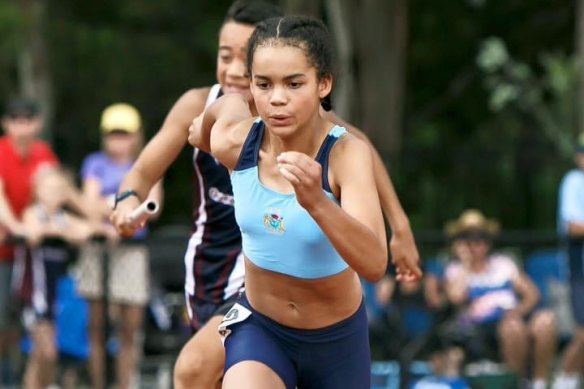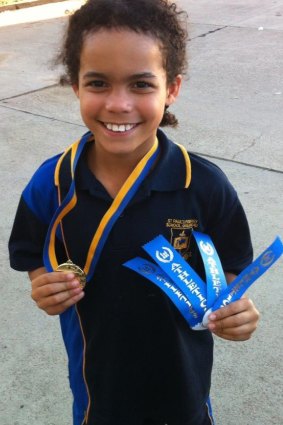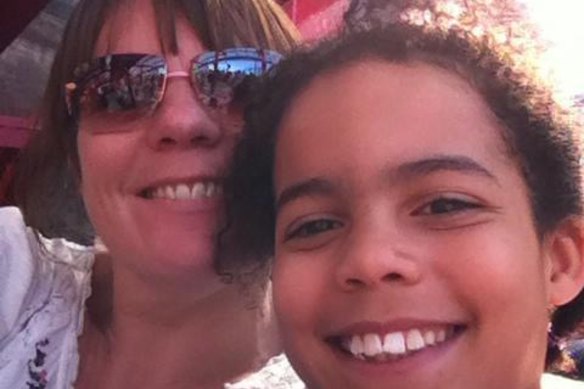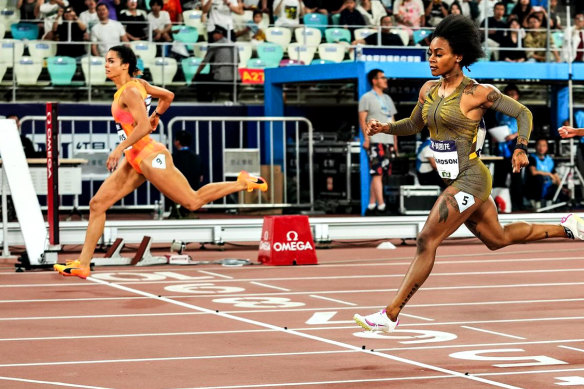How Torrie Lewis became Australia’s fastest woman
A bout of tonsilitis during the 2006 Melbourne Commonwealth Games delivered Australia its fastest woman.
First it was the Commonwealth Games that attracted Torrie Lewis’ mum to Australia. Then it was a diagnosis of coeliac’s disease that pulled Lewis, then in primary school, away from gymnastics and onto the athletics track.
Those two “sliding doors” moments set Lewis on a path to run, not tumble or vault, for Australia instead of England, Scotland or Jamaica at Paris 2024. Until then, any of those options were possibilities.

Torrie Lewis always knew she was fast.
Wendy Lewis was sitting in her house in Nottingham in the midlands of England, feeling like death with a shocking bout of tonsilitis that had kept her from work for more than a week while trying to nurse her toddler daughter. She was awake at nights and, being an avid athletics fan, was watching the Commonwealth Games in Melbourne for half the night.
Australia looked good, she thought. “I wouldn’t mind living there.” Wendy had moved a lot, and said she never envisaged living in the UK long term and bringing Torrie up there.
“I moved to Switzerland when I was 14 and went to language school then Swiss school, but I left at 15. I went back to the UK later to go to college and started getting some education...Now I am a clinical scientist in molecular genetics looking at people’s DNA,” Wendy said.

Lewis was a national level gymnast when she was in primary school.
She had met Torrie’s father, Tony Knight, and had Torrie, but the pair did not stay together for long. Torrie still talks regularly with her dad, who is first generation British Jamaican, and will visit him in the UK.
“The Jamaican influence is no harm to her speed,” Wendy laughed. “But she was beating her dad by the time she was 12. He took her on in a race when he came out to Australia to visit and she beat him. He was reasonably athletic, he played a lot of soccer and a couple of his nephews play pro soccer in the UK, though I am not sure what level.”
After having Torrie, Wendy travelled Scotland for a while but the idea of Australia was itching away in her head. She applied for jobs here and eventually an opportunity opened up.
“I remember Mum was in the shower and there was a call and I answered it. It was the people from a job in Australia Mum had applied for. They said to me they were from Australia, and I was just like, where’s Australia?” Torrie laughed. She was barely six at the time.
Wendy got the job in Australia, boarded a plane with Torrie and migrated, working in Newcastle. Torrie, who had adopted a Scottish accent in the months they lived there, lost that back in Nottingham, then at primary school in Australia was asked, “why do you talk funny?” She quickly adopted the “Strayan” accent.
“We had moved a little bit before that so I had kind of got used to moving and I already liked travelling at that age and seeing new places. I was happy to move,” Torrie said. That was in 2011. Wendy has never been back to the UK.

Torrie Lewis stuck with athletics after she was diagnosed with coeliac disease.
Wendy took her hyperactive daughter to gymnastics first. She was not interested in netball or soccer – “have you heard the parents, Mum?” Through primary school she was training more than 20 hours a week and rising through state to national level competitions.
“She was a national level gymnast. As a nine-year-old she was second at nationals, she’s got state titles in four events – bars, beam and the vaults. I tried to get her into team sports when she was younger and she just flatly refused.
“She did netball at school and I asked if she wanted to keep it up and she said ‘No, I don’t need that drama in my life’.”
“As a 10-year-old she started getting a huge amount of pain at training. I just thought maybe she hit her limit, she was always a power gymnast not a flexible one, but at 11 she got diagnosed with coeliac, an autoimmune disease that reacts to gluten. We realised she had had it for about a year, which explained the pain.”
Once she took time off gymnastics, Lewis said she was never going back again. She loved it, but she had fallen away too quickly to catch up with the other girls. She had started running by then and sprint training was easier by comparison.
“Whenever I have a hard training session I still almost think, well, gymnastics is way harder than this,” Lewis said.
“Running is just a lot more mental than a physical toll. You’re obviously going to have sessions where you vomit and sessions where you’re so sore you don’t know if you can do it, but I think gymnastics was definitely a harder sport to train for, for sure.”

Torrie Lewis with her mum, Wendy, who moved them to Australia when Torrie was six.
Running had half taken her by surprise. She raced at primary school and won easily so she went along to regionals and won, then to state championships.
“I had always known I was fast through school, I would always beat everyone when you had those little races between school friends. When I was eight, that was my first carnival and there were three different levels to get through to state and at every level I would win it and Mum would tell me, ‘oh well the next one, they’ll be faster girls so don’t get upset if you don’t make it through’.
“And then I got to states main final and every single girl on the start line was wearing spikes and I was the only girl in joggers and I came seventh in the final. And I think I said to her, ‘I’m quitting,’ because that was the first time I had lost.” Losing had never crossed her mind because it had never happened before. She didn’t know how to react.
By the time Wendy and Torrie got to the station to catch the train home from Sydney to Newcastle she had changed her mind. She would stick with athletics.
It was about this time Gerrard Keating saw her running. Keating knew a bit about sprinting - he ran for Australia at the world championships in Helsinki and at the Brisbane Commonwealth Games and formerly held the Australian men’s 100m record (10.22s). He knew talent when he saw it and he could see Torrie’s raw talent. He said he’d coach her when she turned 12. Wendy contacted him after Torrie’s 12th birthday and he took her on.
Keating was convinced from the start that Lewis was something special.
“It’s funny because he actually, even then, he said to me and Mum back then when I started training with him when I was 11 or 12, ‘she’ll be running in the Paris Olympics in 2024 when she is 19,’” Lewis said.
“Back then we were like, ‘you’re crazy, that’s just crazy’. And like here I am and basically all his predictions are coming true. He said I would get the Australian record. He obviously thought it would be a little bit later as well, but he knew I could do it.” Lewis has since changed coaches, but the pair are friends.

Torrie Lewis (far left) pips Sha’Carri Richardson to the line in the 200m in China.Credit: Matthew Quine
Keating was right. She was something special.
Lewis is now Australia’s fastest woman, having broken the national 100m record in January when she ran 11.1 seconds. She had just turned 19. In April, she raced her first Diamond League meet – another bucket list item – when she ran 200m in China. She beat world 100m champion Sha’Carri Richardson.
In Paris, Lewis will run the 200m and the 100m relay. It feels to everyone but her, her coach and her mum Wendy as if she has arrived in a hurry.
“I think I always knew I could do it, and I think that was my goal, to be the best in Australia, to compete internationally and be able to hold my own against these girls,” Lewis said.
“So everything that’s happening, it has come sort of out of nowhere to everyone but in my mind, this is the way it’s supposed to be going, this is the way I have planned it and I have seen it. So I’m not necessarily overwhelmed by everything because it’s what I wanted. I’m just glad that it is happening and in the way we’ve trained for and wanted it to happen.”
Now for the Olympics. In those long held plans, what did she see happening in Paris?
“I think if I’m at my best at the Olympics, I can make the semi-final and definitely run a [personal best]. That is definitely the main goal out of this.”
After beating Sha’Carri Richardson, though, it is a little tougher. “I don’t have surprise on my side any more.”
Everyone knows who Torrie Lewis is now. Australia’s fastest woman, delivered by tonsilitis and the 2006 Commonwealth Games.
Sports news, results and expert commentary. Sign up for our Sport newsletter.